In the first part of her two part study on the mysterious Kolbrin ‘Book of Gleanings’, Yvonne Whiteman investigates the possible historical origins of the mysterious ‘Sons of God’ and ‘Daughters of ‘Men’ that appear in Old Testament books as well as in the Kolbrin.
‘And it came to pass, when men began to multiply on the face of the earth, and daughters were born unto them, That the sons of God saw the daughters of men that they were fair; and they took them wives of all which they chose. And the Lord said, My spirit shall not always strive with man, for that he also is flesh: yet his days shall be an hundred and twenty years. There were giants in the earth in those days; and also after that, when the sons of God came in unto the daughters of men, and they bare children to them, the same became mighty men which were of old, men of renown.’ (Book of Genesis chapter 6:1-4.)
Of all the text in the Bible, these lines must be some of the strangest. They baffle all who read them, prompting unanswerable questions. Who were the ‘Sons of God’? Why were the Sons of God differentiated from the ‘Daughters of Men’? What does ‘for that he also is flesh’ mean? Why is a 120-year lifespan mentioned? Were there giants on the Earth in our distant past? Could giants really have been the product of mating between Sons of God and Daughters of men…? If not, what were they?
Scholars often compare Genesis 6:1-4 with some equally strange pages in the Books of Enoch. These are an ancient apocryphal Jewish religious works dating from the 2nd-1st century BC and ascribed to Enoch, the great-grandfather of Noah. The first section of the Books of Enoch tells the story of a mysterious group of angels known as ‘the Watchers’.i
As if Genesis and Enoch were not perplexing enough, the metaphysical pages of the Kolbrin (which has no established provenance) also speak of the Sons or Children of God. One of the Kolbrin’s six Egyptian Books, the Book of Gleanings, contains a lengthy narrative that echoes some of Genesis 6: 1-4 and Enoch, and may predate both.
This is an attempt to bring together the three texts and make sense of them.
Below are the texts. Two different translated snippets from the Books of Enoch have been included because they give slightly different place-names; key phrases are in red.
From the Book of Genesis 6: 1-4, King James Version (KJV)
‘And it came to pass, when men began to multiply on the face of the earth, and daughters were born unto them,
That the sons of God saw the daughters of men that they were fair; and they took them wives of all which they chose.
And the Lord said, My spirit shall not always strive with man, for that he also is flesh: yet his days shall be an hundred and twenty years.
There were giants in the earth in those days; and also after that, when the sons of God came in unto the daughters of men, and they bare children to them, the same became mighty men which were of old, men of renown.’
From the Books of Enoch, chapters 6-8, R. Laurence trans., 1883
‘It happened after the sons of men had multiplied in those days, that daughters were born to them, elegant and beautiful. And when the angels, the sons of heaven, beheld them, they became enamoured of them, saying to each other, Come, let us select for ourselves wives from the progeny of men, and let us beget children…
Then they swore all together, and all bound themselves by mutual execrations. Their whole number was two hundred, who descended upon Ardis, which is the top of mount Armon. That mountain therefore was called Armon, because they had sworn upon it, and bound themselves by mutual execrations.’
From the Books of Enoch. Chapters 6-8, R.H. Charles trans., 1917
‘And it came to pass when the children of men had multiplied that in those days were born unto them beautiful and comely daughters. And the angels, the children of the heaven, saw and lusted after them, and said to one another: ‘Come, let us choose us wives from among the children of men and beget us children.’ … And they were in all two hundred; who descended in the days of Jared on the summit of Mount Hermon, and they called it Mount Hermon, because they had sworn and bound themselves by mutual imprecations upon it…
And all the others together with them took unto themselves wives, and each chose for himself one, and they began to go in unto them and to defile themselves with them, and they taught them charms and enchantments, and the cutting of roots, and made them acquainted with plants. And they became pregnant, and they bare great giants, whose height was three thousand ells: Who consumed all the acquisitions of men. And when men could no longer sustain them, the giants turned against them and devoured mankind. And they began to sin against birds, and beasts, and reptiles, and fish, and to devour one another’s flesh, and drink the blood…
And Azâzêl taught men to make swords, and knives, and shields, and breastplates, and made known to them the metals [of the earth] and the art of working them, and bracelets, and ornaments, and the use of antimony, and the beautifying of the eyelids, and all kinds of costly stones, and all colouring tinctures. And there arose much godlessness, and they committed fornication, and they were led astray, and became corrupt in all their ways…’
From the Kolbrin, Book of Gleanings
Chapters 1, 4:13-14
‘It came about that the sons of The Children of God mated with the daughters of The Children of Men, who knew well the ways of men and were not reserved. The covenant had been broken and strange women were taken into the households, some even as wives; but though the daughters were lesser women, the sons were wonderfully big and mighty fighting men.
These new people came out of the wastelands and crossed to Kithermis… This was when the years of man’s life were lessened because he became fully Earth-sustained, but he remained full of vigour though filled with hostility, particularly towards those who loved.
4: 13
One day, from afar off came three men of Ardis, their country having been stricken by a mountain burst. They were worshippers of The One God whose light shines within men, and when they had lived in the two cities for a number of days they were stirred up in their hearts because of the things they saw. So they called upon their God to see these evil things. Their God sent down a curse upon the men of the cities, and there came a strange light and a smoky mist which caught at the throats of men. All things became still and apprehensive, there were strange clouds in the skies and the nights were hung with heaviness. Many days passed before a north wind came and the skies cleared; but then, when women conceived they bore devils. Monstrosities came forth from their wombs, whose faces were terrible and whose limbs were unproportioned.
14
In those days men knew the art of working clay and making linen in bright colours, and also the use of eye paint. They had knowledge of herbs and magic, of enchantment, and the wisdom of The Book of Heaven; the knowledge of signs and omens, the secrets of the seasons, of the moon and the coming of the waters.’
What Genesis, Enoch and the Kolbrin have in common
Sometimes Genesis 6:1-4 and Enoch share a phrase or event, sometimes the Kolbrin and Genesis, sometimes Enoch and the Kolbrin. But what all three have in common is that they speak of the Sons of God mating with the Daughters of Men and producing giants or monstrosities. This suggests that they contain the same core story. Clearly, whatever happened was an immensely important event in human history.
Each text offers a different perspective on the events they describe. Genesis 6:1-4 contains an abrupt, truncated story dominated by an all-seeing, judgmental God. The Enoch narrative focuses on the activities of a pantheon of angelic beings. The Kolbrin tells its story in a slower, more measured way than either Genesis or Enoch, with no mention of either angels or giants.
Who or what were Angels?
The Books of Enoch tell the story of beings called ‘angels’. The Oxford English Dictionary defines ‘angel’ as ‘a ministering spirit or divine messenger… superior to man in power and intelligence, who, according to the Jewish, Christian, Islamic, and other theologies, are the attendants… of the Deity’. The word comes from Greek/Latin/Old Germanic, but the more ancient word from which ‘angel’ derives is now lost.
Enoch uses the word ‘angels’ interchangeably with ‘sons of heaven’. Chapter 4 of the Old Testament’s Book of Daniel contains three references to beings called ‘watchers, holy ones’ (watcher: Aramaic `iyr; holy one: Aramaic qaddiysh) which are identified with angels. Another term for watchers ̶ ‘Grigori ̶ (Greek: ἐγρήγοροι, transl. egrḗgoroi, Slav transliteration, Grigori) can be found in Enoch and also in the Septuagint translation of the Old Testament Book of Lamentations, the Book of Jubilees,ii the Damascus Documentiii and the Zohar.iv
The Kolbrin makes no mention of angelic beings, but is in no doubt about the identity of the Sons of God. Its first two Egyptian books, Creation and Gleanings, contain no less than 29 references to ‘Children of God’, three to ‘Sons of God’ (‘Children’ and ‘Sons’ are used interchangeably) and one to ‘daughters of the Sons of God’. The Books of Creation and Gleanings are effectually a history of the Sons of God.
To avoid confusion, the term ‘Sons/Children of God’ will be used throughout this article rather than ‘Angels’, ‘Watchers’ or ‘Grigori’.
Who were the Sons of God?
The Sons/Children of God make their first appearance in the Kolbrin’s Book of Creation, in a text written by Kerobal Pakthermin:
‘The forebears of all the nations of man were once one people, and they were the elect of God who delivered all the Earth over to them, all the people, the beasts of the field, the creatures of the wasteland and the things that grow. They dwelt through long ages in lands of peace and plenty. There were some who struggled harder, were more disciplined; because their forefathers had crossed the great dark void, their desires were turned Godward and they were called the Children of God…’v
In other words, the Sons/Children of God had different ancestry from other ‘forbears’ (‘their forefathers had crossed the great dark void’) and were more advanced than the peoples living around them.
‘Time passed and The Children of God were grown strong and upright under the tempering hammer of God… [they] were not yet the heirs of God nor inheritors of godhood… there was one among them who… was wise and knew all things… So because he walked with God he was culled out from his kind…‘ vi [Who culled him out? We are not told.]
This Son of God, Fanvar, was sent to ‘the Gardenplace’ in the Indus Valley,vii and a woman called Aruah was created to be his mate.viii She was unlike any other woman existing on Earth at that time, for she ‘followed the ways of the cradleland, not the ways of Earth’.ix To keep sickness and disease away, this chosen couple regularly drank ‘sacred substances’ ‘when the Heavens were in a proper position’, and their direct descendants did the same, but these substances were forbidden to anyone else because they caused ‘a wasting away‘.x The Children of God were ‘altogether forbidden‘ (by whom? one wonders) to mate with the other humanoid species around them.
Putting together what the Kolbrin says about the Sons/Children of God ̶ ‘their forefathers had crossed the great dark void’… that their women ‘followed the ways of the cradleland, not the ways of Earth’ … that they gradually ‘became fully Earth-sustained’xi ̶ something extraordinary emerges: the Kolbrin is saying that the ancestors of the Sons of God came from a place that was not Earth.
Where did the Sons of God ‘descend’?
The Books of Enoch say that the Sons of Heaven ‘descended’ (where from? No-one knows) ‘upon Ardis/Ardos, which is the top of mount Armon’ (Richard Laurence translation)xii or ‘on the summit of Mount Hermon’ (R.H. Charles’s later translation)xiii. Mount Hermon is a mountain cluster whose summit straddles the border between Syria and Lebanon.
The place-name Ardis is unknown in any other ancient text ̶ indeed, the latest translation of Enoch has dropped the name altogether. But ‘Ardis’ is there in the Kolbrin, where it is mentioned no less than ten times. Ardis was ‘beside Krowkasis [the Caucasus], land of mountains and rivers‘xiv. It was bordered by ‘Arania’ (a skewed version of aryānām – proto-Iranian, meaning ‘of the Aryans’; it is an ancient name for Iran, which borders on Armenia)xv. The name ‘Ard-is’ has a root similar to ‘Urdekhe’ (a place mentioned in the inscriptions of the kingdom of Urartu/ancient Armenia) and also to ‘Ardakhe’ /’Artsakh’, an ancient province of Armenia.xvi This Ardis was in the Armenian highlands of the Lesser Caucasus, a mountain range bordering Turkey and Iran.
So which Ardis location is the right one ̶ Ardis in the Lebanon/Syria mountains or Ardis in the Armenian highlands?
When R.H. Charles translated the Books of Enoch, he was convinced that the name ‘Armon’ referred to Mount Herman because ‘Herman’ comes from the Hebrew herem/chermow, meaning ‘curse’ (though it also means ‘seclude’, ‘devote’, ‘consecrate’); and since the Sons of Heaven ‘had sworn and bound themselves by mutual imprecations upon it’, Mount Hermon seemed to fitxvii. But Armon can also be identified with a place called ‘Armani/Armanum’ found in Akkadian inscriptions from Narram-Suen (2300 BC), with ‘Armina’ in Achaemenid inscriptions of Darius 1 (600, BC), and with ‘Harminuia’ (Elamite). These are all names for the Armenian highlands in the Lesser Caucasus.xviii No-one knows where the root ‘Armen-/Armon-‘ comes from or what it means. Armenians call their country ‘Hayk’.
There is an even stronger reason for identifying ‘Armon’ with the Lesser Caucasus. Richard Laurence looked hard at the lengths of daylight time described in the Books of Enoch, and wrote in his 1883 introduction:
‘If… we consider in what latitude a country must be situated to have a day of sixteen hours long, we shall immediately perceive that Palestine could not be such a country… the region in which the author lived must have been situated not lower than forty-five degrees north latitude, where the longest day is fifteen hours and a half, nor higher perhaps than forty-nine degrees, where the longest day is precisely sixteen hours. This will bring the country as high up at least as the northern districts of the Caspian and Euxine [Black] seas; probably it was situated somewhere between the upper parts of both these seas.’xix
The area between the upper parts of the Caspian and Black Seas is the Lesser Caucasus containing the Armenian highlands.
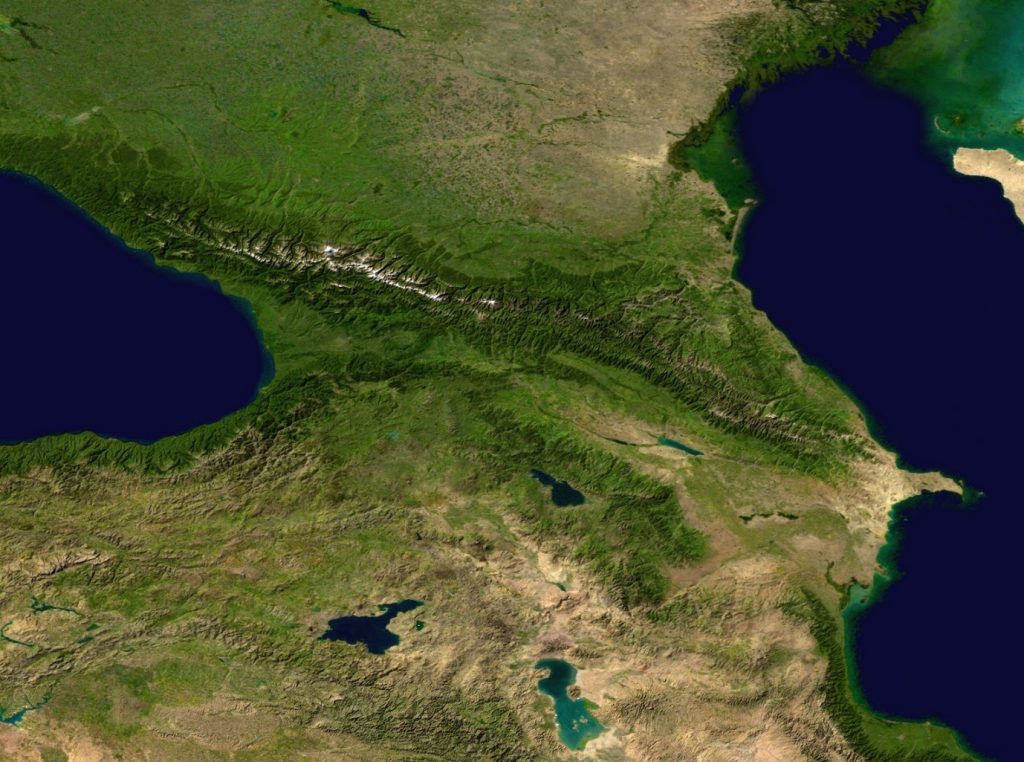
Map of southern Caucasus mountains, showing the Black Sea to the west and the Caspian Sea to the east. ©NASA
Another indication that Ardis was in the Armenian highlands comes from a sentence in the Kolbrin: ‘One day, from afar off came three men of Ardis, their country having been stricken by a mountain burst.’xx A ‘mountain burst’ is an oldfashioned term for a volcanic eruption. Historically, the Lesser Caucasus has always been an active volcanic area; Mount Hermon has not. So it is likely that the Sons/Children of God first ‘descended’ on the Armenian highlands and settled there.
Different kinds of knowledge
The Books of Enoch and the Kolbrin both speak of men having certain kinds of knowledge. The Kolbrin says that they knew the arts of working clay, dyeing linen, using herbs, magic and astronomy. Enoch says that the angels taught their human wives these same arts. These two texts are so close in content that they almost certainly derive from a similar source.
First inter-species mating
But tragedy loomed for the Sons of God. One day, Fanvar’s great-great-granddaughter Maeva disobeyed the universal taboo on mating between species (imposed by whom, one wonders) and was drugged and seduced into having sex with one of the ‘Yoslings’xxi ̶ a humanoid species living outside the Gardenplace who were ‘not true men but… kinsfolk to the beasts of the forest’.xxii The Yosling in question was Lewid the Darkfather. Reading between the lines, it sounds as if the ‘more disciplined’ Sons of God were not as libidinous as the humanoid species living around them. Soon after they had sex, Maeva fell ill. It is clear that illness was new to her, and equally clear that the Sons of God had little immunity to new bacteria, much like the South American Incas in the 16th century AD when first they encountered the Spanish conquistadors.xxiii
Lewin and his fellow Yoslings also managed to get their hands on some of the sacred substances forbidden to their species; after drinking, they fell ill and many died, including Lewin. According to the Kolbrin, women’s monthly periods, painful childbirth and the thousands of diseases humans are prone to, stem from this time when the Yoslings mated with the Sons of God and drank their sacred substances.xxiv
After this misadventure, earthquakes and climatic change forced the Children of God out of the Indus Valley and they made their way south of the Caspian Sea to Krowkasis, ‘land of mountains and rivers, which is beside Ardis’,xxv where they settled until driven out again by climate change and moved west. Pliny the Elder’s Naturalis Historia states that Krowkasis is the Scythian name for the Caucasus.xxvi
Generations later, Son of God Fanvar’s great-great-grandson Herthewxxvii married Gwineva, the ‘cuckoo-child’ offspring of Child of God Maeva and Yosling Lewid; she was the first red-haired human ever (could she have been the first Neanderthal?) and the text implies that she was the only Child of God-Yosling species in the world for a long time to come.xxviii Later, as increasing numbers of Child of God-Yosling children were born, this new species came to be known as ‘the Children of Men’.
Second inter-species mating
As if this genetic disaster was not enough, the Book of Gleanings records a second mis-mating, this time between the Sons of Men (part Son of God/part Yosling) and another species:
‘Once all men were dark and hairy and in those days woman was tempted by the strength and wildness of the beast which dwelt in the forest, and the race of man was defiled again… Now, because of the wickedness that was done, there are among men those who are the Children of the Beast, and they are a different people… The race of man alone was punished, for the beast acted according to its nature. In man the beast and god strive to decide whether he shall take his place among the gods that live or the beasts that die, and woman, in her weakness, betrayed him to the beast.’xxix
Note the words ‘defiled again’. The first time round, a Child of God mated with a Yosling; the second time round, one of these mixed-species offspring (who came to be called ‘Children of Men/Sons of Men/Daughters of Men’) mated with an unidentified species. The text implies that the Daughters of Men were used to having dark, hairy (i.e. wild-looking) men as mates and so were equally attracted to ‘the beast which dwelt in the forest’.
What did the Sons of God and Sons of Men look like?
If the Sons of Men were dark and hairy, this begs the question: what did the Sons of God look like? The Kolbrin doesn’t tell us, but the Books of Enoch give a clue. They include a description of the newborn baby Noah, son of Lamech and grandson of Methuselah.
‘…His body was white as snow and red as the blooming of a rose, and the hair of his head and his long locks were white as wool, and his eyes beautiful. And when he opened his eyes, he lighted up the whole house like the sun… And his father Lamech… came to his father Methuselah. And he said unto him: ‘I have begotten a strange son, diverse from and unlike man, and resembling the sons of the God of heaven; and his nature is different and he is not like us, and his eyes are as the rays of the sun, and his countenance is glorious. And it seems to me that he is not sprung from me but from the angels.’xxx
The baby Noah is clearly a throwback to Lamech’s Son of God/Angel forebears. The dark, hairy appearance of the Sons of Men suggests that when the Sons of God mated with Yoslings, Yosling DNA proved the stronger ̶ Yoslings, after all, had evolved on Earth and were therefore likely to be a hardier species.
Who or what was the ‘beast which dwelt in the Forest’? It was not a Yosling, for Yoslings had already interbred with the Sons of God and ‘defiled’ the species. It might have been a creature of the Yeti / Bigfoot / Sasquatch variety, or one of the now-extinct species known as Paranthropus robustus.xxxi Or ̶ stretching possibilities even further ̶ it might have been a creature even more bestial, if, at this early evolutionary stage; DNA was more fluid and adaptable than it is now.
Four different species
The following Gleanings text flashes light on the various humanoid species in the world at that distant time:
‘A racexxxii of men came out of the cold northlands. They were under a wise father and above them was the Grand Company which later withdrew in disgust. This race was the Children of God; they knew Truth and lived in the midst of peace and plenty. The Children of Men about them were wild and savage; clothed in the skins of beasts they lived like beasts. Even more wild were the Men of Zumat who lived beyond them.’
No less than four different species are enumerated here. Who or what were they?
The Grand Company
The Grand Company are not mentioned anywhere else in the Kolbrin. The context suggests they were at the top of the civilization hierarchy. Were they perhaps the same beings referred to in Sumerian, Akkadian, Assyrian and Babylonian records as the ‘Annunaki’ ̶ the ‘Grand Assembly’, ‘princely offspring’, ‘those of royal blood’?xxxiii The Grand Company were clearly so appalled by the Sons of God’s inter-species mating ̶ a huge evolutionary step backwards ̶ that they withdrew in disgust. This suggests they had been taking a close interest in the progress of the Sons of God. Might the Grand Company have been ‘Elohim’ ̶ the plural term for God sometimes used in the early Old Testament books?
The Children/Sons of God
The Children of God were more advanced than the other species living around them. When eventually they mated with the daughters of the Children of Men and a ‘new people’ emerged, ‘the years of man’s life were lessened because he became fully Earth-sustained‘.xxxiv This implies that the Children of God lived longer than the other humanoid species.
The Daughters of God
The Daughters of God were high-status, advanced beings. Aruah, the woman created to be Fanvar’s mate, came of an even more refined species:
‘Amongthe ChildrenofGodwomanhad equality withman,forher counsels were known tobe wise. Sheheardwithunderstandingand her speech wasconsidered; inthosedays her words were weighed…’xxxv
The Sons of God
‘valued woman highly and protected her from crudeness and cruelty, and her standing was such that she was awarded only to the most worthy of men. They held her in respect, for to them she was the fountain of life within their race, the designer of its future. Yet even so they had to restrict her, for she was inclined to be wilful and unheeding of her responsibility.xxxvi
What was ‘a true woman’?
The Kolbrin records that much later, in a place called ‘Shinara’ (Shinar is known to be an area in ancient Mesopotamia), some of the Children of God ‘left to dwell among the Children of Men’,xxxvii and ‘the daughters of the Children of God consorted with the sons of the Children of Men and were become unlike true women’.xxxviii This begs the question: what constituted a ‘true woman’?
In the early days of the Gardenplace, the woman Aruah given to the Son of God Fanvar is described as
‘not as other women… every hair of her head is unlike that of a man, every drop of blood and every particle of flesh is that of a woman and quite unlike that of a man. Her thoughts and desires are different; she is neither coarse nor uncouth, being altogether of another, more refined realm. Her daughters will walk proudly, endowed with every womanly perfection and grace. Delicacy, modesty and charm will be the lovely jewels enhancing their womanliness.’
She also had
‘twinsight, an ability to see wraiths and sithfolk, ansis [some kind of supernatural beings?] and spiritbeings, all the things of the Otherworld, not clearly but as through a veil.”xxxix
Clearly this female was cerebral, aesthetic and deeply psychic ̶ the complete opposite of the daughters of the Children of Men, who ‘knew well the ways of men and were not reserved’ ̶ in other words, they were down-to-earth and sexually assertive.
The Children of Men
The Children of Men were the mixed-race offspring of sexual liaisons between Daughters of God and Yoslings. Gwineva was the first ‘cuckoo-child’. This species inherited Children of God genes which gave them a longer lifespan than that of Yoslings. But they were barbaric: ‘clothed in the skins of beasts, they lived like beasts’. They ‘inherited the wastelands’xl ̶ which might have been uncultivated land or land unusable after earthquakes, fire or flooding.
Among the barbaric Children of Men, woman was merely ‘a chattel. She was subject to man, an object for the satisfaction of his lust and the servant to supply his needs. He subdued her and kept her in servitude, for her betrayal of man was known even among them, and it was never forgotten, nor could it be forgiven.’xli
The words ‘her betrayal of man’ leap off the page. Could this betrayal be a memory so deeply buried in the human psyche that we have carried it forward without remembering what triggered it in the first place? Immanuel Velikovsky and Graham Hancock have both pointed out that we are a species with amnesia. When we have to deal psychologically with unimaginable events in our past ̶ whether global cataclysms or genetic disasters ̶ we prefer to forget them. This tragic human weakness is mentioned in the Kolbrin account of Earth’s first destruction by fire:
‘So awesome was the fearfully aspected thing that the memory mercifully departed from man, his thoughts were smothered under a cloud of forgetfulness… Time passed, memory dimmed and the record of events was no longer clear. Generation followed generation and as the ages unfolded, new tongues and new tales replaced the old.’xlii
Could it be that in our own time, the unfocused sense of gumailt experienced by many women and the conviction in some men that female sexuality needs to be curbed (an extreme manifestation being Female Genital Mutilation), might date back to the two forbidden inter-species matings and the evolutionary misery that ensued? According to Gleanings, FGM was usual in Egypt when Yosira/Osiris first came to Egypt (the Kolbrin says he was a real person who was later made a god). Yosira/Osiris introduced the ruling: ‘To sew or cut the private parts of any woman is a great wickedness, for this is the portal of life and woman is not an unworthy guardian.’xliii The Kolbrin observes that, as mankind’s lifespan shortened, human beings were ‘filled with hostility, particularly towards those who loved’.xliv
The Men of Zumat/Yosling
The Men of Zumat (also called the ‘Children of Bothas’) were ‘not true men but Yoslings, kinsfolk to the beasts of the forest’.xlv ‘Men of Zumat’ means ‘They who inherit Death’. This species inhabited the wastelands, lived short lives and was even lower down the civilisation scale than the Children of Men. Teaching the Children of Zumat more civilised ways was one of the duties of the Children of Godxlvi (a duty allocated to them by whom? one wonders).
The Children of the Beast
These were yet another ‘different people‘, the product of matings between the Children of Men (mixed-race Sons of God/Yoslings) and ‘the beast which dwelt in the forest‘.
Later in Gleanings, mention is made of warfare in which one huge army was made up of ‘the Children of Githesad the Serpent, the Cunning One, whose mother was one of those who brought defilement into the race of men.’xlvii (The word ‘serpent’ does not necessarily mean ‘snake’ here, since its old meaning included ‘cunning one’; but the Children of Githesad could well have been the mixed-species offspring of a Daughter of Men and a ‘Beast’.) Statues found of reptilian-headed beings nursing their babies in Ubaid archaeological sites (northern Mesopotamia, 4500-4000 BC) suggest that there might once have been mixed-species humanoids.
Among the Rules of Yosira/Osiris in the Book of Gleanings is a reference to ‘All men who were blood kindred with the beasts of the forest or with fowl or with serpent, [who] dwelt together according to their kinship, and were divided thereby. Yosira forbade them not their kinship but did forbid the rule of blood.’xlviii This implies that the Children of the Beast ̶ who might have been an animal-human hybrid species ̶ were still in existence in early Egyptian times.
The 20th-century ‘Sleeping Prophet’ Edgar Cayce said of these hybrids:
‘It was the mixing of those of pure lineage with those who had not completely overcome the animal influences that brought dissensions and the rise of strife and turmoil… There were some who were almost perfect in figure and feature; and others who had monstrous combinations of human physiques and animal appendages, such as hooves, claws, feathers, wings, and tails. It was these strange creatures who later were to be so mysteriously depicted in Egyptian and Assyrian inscriptions. At an early period in Egypt they were finally to disappear from the human race.’xlix
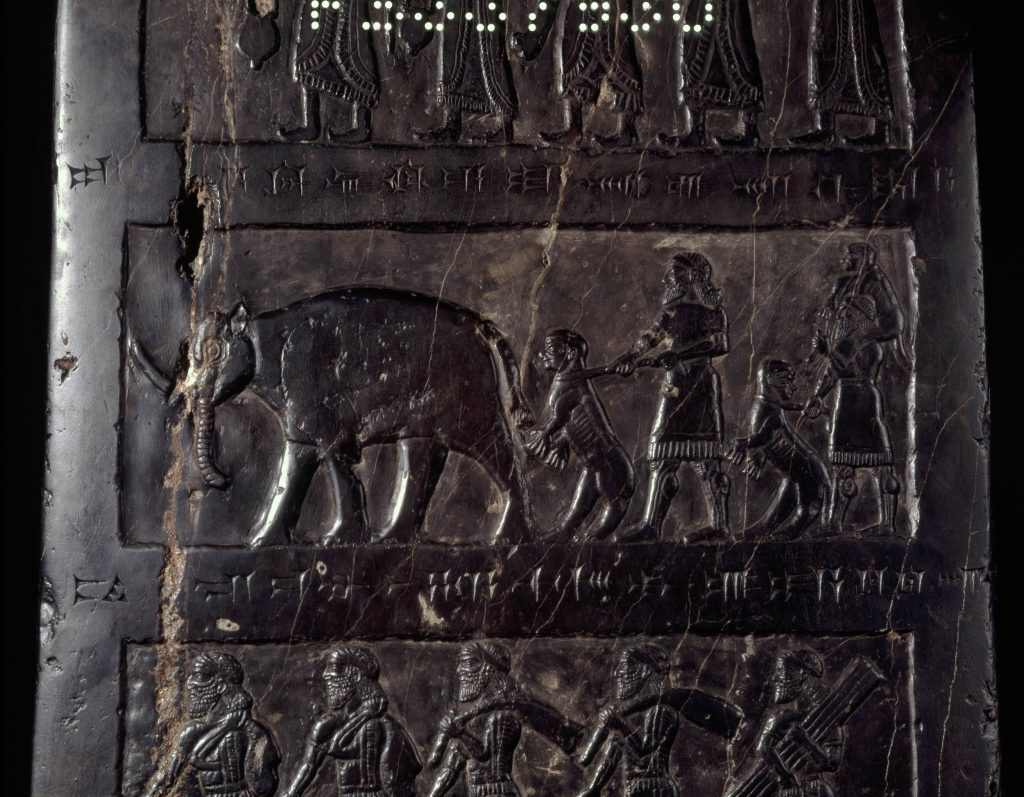
The Neo-Assyrian Black Obelisk of Shalmaneser III found at Nimrud, Iraq (825 BC) depicts tributes brought from ‘Musri’/Egypt and four other places. The Egyptian tribute includes an elephant and what are termed ‘exotic animals’ which are clearly animal/human hybrids or ‘mixtures’. ©British Museum
If this stretches the credulity of readers, they should take a look at Jim Vieira and Hugh Newman’s book Giants on Record: America’s Hidden History, Secrets in the Mounds and the Smithsonian Files. A chapter entitled ‘Anatomic Anomalies’ lists three horned skeleton humanoid finds, one in Toledo, Ohio, one in Sulphur Springs, Indiana, and a group of four-foot skeletons with horns and ‘long tails’ at Repmans Hill, Virginial. The British Newspaper Archives contain another report from the Western Daily Press, dated Thursday 9 June 1870, taken from the Pall Mall Gazette: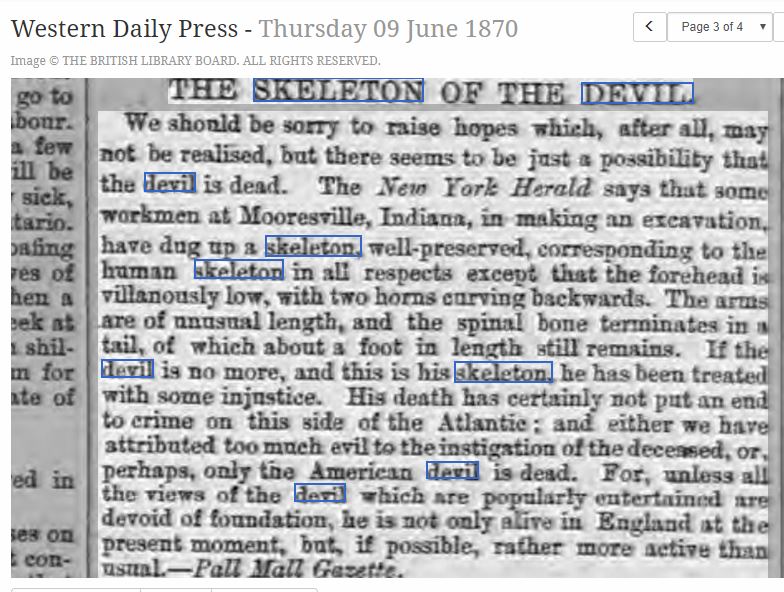
The Sumerians, Babylonians, Ancient Egyptians and Ancient Greeks depicted all manner of human-animal hybrids in their art and sculpture; we appreciate them as fantastical art and relegate them to a category we have named ‘mythology’. Perhaps we need to ask ourselves, why did the ancients depict so many of these creatures? Could they represent lost memories of Children of the Beast in our distant past?
An internet search soon confirms that, even today, a handful of humans display DNA throw-back genes-from horns and tails to double rows of teeth and not-so-rare six fingers and toes (both characteristic of giant DNA).li This gives new meaning to the age-old question asked anxiously by every mother after birth: ‘Is my baby alright?’ Nowadays, extra fingers or toes are tied off with thread by a nurse just after birth so that they quickly drop off (one of my nieces was born with what are euphemistically called ‘spurs’ on both hands).lii Such conditions are dignified with names such as polydactylism, cutaneous horn and vestigiality/ coccyx, and quietly dismissed. Not all the internet photographs are forgeries.
Gradual mixing of species
The Book of Gleanings speaks of great climatic change before the Deluge,
‘the lengthening of the years, when the time of sowing was confused and seed died in the ground. In those days, Enos [the son of Seth, according to Genesis] came up out of Chaisen and spoke for the god of the Children of Men. In those days, there were many having the blood of the Children of God who inclined their ears towards his words, for they thought the Great God of their fathers had abandoned them.’liii
This tells us that the Children of God interbred with the Children of Men (who were part Child of God/part Yosling) more frequently as time went on, introducing additional Child of God genes into the DNA mix.
The human lifespan shortens
What does that mysterious line in Genesis, ‘yet his days shall be an hundred and twenty years’ mean? Below is a list of Adam’s bloodline before and after the Flood as listed in Genesis, giving his male descendants’ lifespans in years:
Adam 930
Seth 912
Enos 905
Cainan 910
Mahalaleel 895
Jared 962
Enoch 365
Methuselah 969
Lamech 787
____________
THE FLOOD
Noah 950
____________
Shem 600
Arphaxad 438
Eber 464
Peleg 239
Reu 239
Serug 230
Nahor 148
Terah 205
Abraham 175
Ishmael 137
Isaac 180
Jacob 147
Joseph 110.liv
This list shows that following the Flood, the length of human life gradually decreased. Historians tie themselves in knots trying to explain these incredibly long Biblical lifespans, or simply dismiss them altogether. But lengthy lifespans of this kind are corroborated both by the Sumerian King Lists (Apkullu List/Berossus as quoted in the Babyloniaca/the Dynastic Chroniclelv) and by the Egyptian lists of pharaohs (Palermo King Listlvi and Turin King Listlvii).
The Kolbrin states matter-of-factly that the lives of the Children of God grew shorter: ‘the years of man’s [Sons of God] life were lessened because he became fully Earth-sustained‘lviii; while the Children of Men, who combined Yosling and Son of God DNA, gradually began to live longer: ‘Once man [Sons of Men] lived for less than two score years, now his years were three score and ten.’ lix This was the result of inter-species breeding. Before the interbreeding, the long-lived Sons of God would have seemed virtually immortal to shorter-lived humanoids.
The Fall of Man
‘The Fall of Man’ is not a term mentioned in Genesis, Enoch or the Kolbrin, but it underlies the story in all three. Genesis describes it as the transition of the first man and woman from innocent obedience to God, to guilty disobedience. Enoch tells of a mis-mating between an angelic species and the daughters of men which resulted in cannibalistic, vampiric giants.lx The Kolbrin states that the ‘disobedience’ consisted in mating between Daughters of God and two other, more primitive species which led to a falling away from the Children of God’s genetic path, ruining their future forever. Nowadays, mating between different groups would be regarded as healthy genetic practice; but the Sons/Children of God were on an evolutionary quest towards higher things ̶ chief among which, says the Kolbrin, was immortality itself. But now they could not go back. Thonis of Myra in Ludicia says in the Book of Creation,
‘the eyes of the man and woman were opened and, being above the beasts, they knew they were different and set apart from all else that breathed…They had fallen into carnal knowledge which only man can know, for only he feels the reproach of divinity… and could not return because of the barrier between man and non-man”.lxi
For a while, the Sons of God nursed a belief that their genetic inheritance had not been entirely lost:
‘The unfolding spirit residing in those who have the blood of the Children of God and the greatness that dwells in men shall be magnified in the blood of their children. Their wisdom shall be greatly multiplied, if the tie of blood be strong… There is a virtue in the blood of those whose forebears were the Children of God, and if two people having this blood marry, then this virtue is increased in their children, so it is greater than either parent… So let women choose the best among men that they can and let men choose the best among women.’lxii
In other words, they thought they could retrieve matters by careful inbreeding. But the deed had been done and they could not go back. Later on, Gleanings says:
Ten thousand generations had passed since the beginning and a thousand generations since the re-creation. The Children of God and The Children of Men had passed into dust and only men remained. One hundred generations had passed since the overwhelming deluge and ten generations since The Destroyer last appeared. Once man lived for less than two score years, now his years were three score and ten.’lxiii
[For more on the Destroyer, see my article ‘The Kolbrin: on who built the Great Sphinx, and why’ (10 March, 2018)].
The last of the Sons of God
In the Book of Manuscripts, the Ancient Egyptian scribe Thotis tries to pinpoint where the Old Motherland of the Ancient Egyptians might have been before their ancestors found refuge in Egypt. He says:
‘The first land on Earth wherein men dwelt was not Kahemu [Khemit/Egypt], it was a land out beyond the salt waters. To this land came the Immortal Spirit in the form of a Radiant One from Heaven, who had left his more enlightened place to dwell among beasts in the lower kingdom of sorrow. In some mysterious way he became incarnated as man, how we know not, but he founded the race of man. It is not as recorded in tales told for the ignorant.’lxiv
Thotis speaks with pride of the ‘Great House of the Hidden Places’ which once stood in the Old Motherland and is now rebuilt in Egypt:
‘Within it lies the Womb of Rebirth used by the Twice Born of the Enlightened Ones. Men enter its portals to die and come out restored to life, reborn as gods. Beside it stands the Temple of the Radiant Ones, many-pillared and walled about. Here is the Great Portal of Entry into Life, and above it, on a great stone, these words may be seen: ‘From the Children of God to the Children of Men. Behold, we found you in bondage to mortal bodies and bestowed upon you the gift of everlasting life.’lxv
This implies that the Sons/Children of God possessed knowledge of immortality and passed it on to the people of Ancient Egypt.
Surprisingly, one of the Celtic Books contains a reference to the Sons of God. During the Britain Book’s account of Joseph of Arimathea’s arrival in Britain in the 1st century AD, Joseph explains to the Chief Druid what the Christian and Druid cultures have in common, and says:
‘Because you are folk who work the land, bringing it to fruitfulness, you are not to be despised. Let the newcomers with their armed might [the Romans, who regarded the British as barbarians] say as they will, you are workers with God. Were not the Sons of God also called the Sons of the Plough? Did they not fight against the Sons of Men who were hunters eating raw flesh like the beasts and worshipping serpents which crawl on their bellies? Always there have been some who worship things of insensitive wood and stone, grovelling in the dust at their feet, and those who worship the highest they can see, the sun and the stars. Others reach out even beyond these.’lxvi
From this it emerges that Joseph and the Chief Druid shared a common historical knowledge of the Sons of God and the Sons of Men that the Sons of God were ‘Sons of the Plough’, known for their agriculture, in contrast to the barbaric Sons of Men, and that their cultural differences had led them into conflict in the past.
So, in the light of the Kolbrin records, those puzzling words in Genesis, ‘the sons of God saw the daughters of men that they were fair; and they took them wives of all which they chose’ take on a whole new meaning.
References
i Both Jewish and Christian denominations discarded the Books of Enoch as non-canonical many centuries ago, but the books are still recognised by the Ethiopian and Eritrean Orthodox Tewahedo Churches. Outside Ethiopia the texts were considered lost until 1773, when the Scottish traveller James Bruce returned to Europe from Abyssinia with three copies of the Books of Enoch. The first English translation was made by Richard Laurence in 1821/1883. Remnants of the Books of Enoch in Aramaic and additional Enoch texts were discovered among the Dead Sea Scrolls at Qumran on the West Bank in Israel. The most important of these is the fragmentary Book of Giants.
iii The Damascus Document in The Complete Dead Sea Scrolls, G. Vermes revised ed., 2004.
iv ‘The Revelation of the Book of Zohar in Our Time’, B. Baruch, Kabbalah Education & Research Institute.
v Kolbrin, Book of Creation 4:1-4.
vi Kolbrin, Creation 5:8-9.
vii Kolbrin 5:16.
viii Kolbrin, Creation 5:13-14.
ix Kolbrin, Creation
x Kolbrin, Creation 5:23.
xi Kolbrin, Gleanings 2:2.
xii The Book of Enoch, R. Laurence trans. from the Ethiopic text, 1883.
xiii The Book of Enoch, R. H. Charles trans., 1917.
xiv Kolbrin, Creation 7:2
xv Birth of the Persian Empire: The Idea of Iran, edited by Vesta Sarkhosh Curtis, Sarah Stewart (London Middle East Institute, British Museum). 2005.
xvi See The Caucasian Knot: The History and Geo-Politics of Nagorno-Karabagh, Chorbajian, L.; Donabedian P.; Mutafian, C. NJ: Zed Books, 1994, p. 52. Also see The Armenian presence in Mountainous Karabakh, Walker, C. in John F. R. Wright et al.: Transcaucasian Boundaries (SOAS/GRC Geopolitics). 1995, p. 91.
xvii The Book of Enoch, R. H. Charles trans., 1917, Introduction.
xviii See ‘The History of Armenia‘ on Institute of Armenian Studies, University of Yerevan and ‘Armenia and Iran i. the Achaemenid Province‘ on Encylopedia Iranica and ‘Toponyms Armenia and Urartu‘ on Western Armenia TV.
xix The Book of Enoch, R. Laurence trans. from the Ethiopic text, 1883.
xx Kolbrin, Gleanings 4:13
xxi Kolbrin, Creation 27-32
xxii Kolbrin, Creation 5:22-24
xxiii Kolbrin, Creation, 29-32
xxiv Kolbrin, Creation 34-5
xxv Creation 5:21, 37; 7:2
xxvi The mountain range name is from Greek kaukhasis, from Scythian kroy-khasis, lit. ‘(the mountain) ice-shining/white with snow.’, Naturalis Historiae, Pliny the Elder, AD 77-79.
xxvii The Herthew saga will enthral anyone interested in King Arthur. It has a Merlin-type figure, a sword in a stone and several other motifs which appear in the King Arthur legends; this Caucasus-Camelot connection is explored in From Scythia to Camelot: Radical Reassessment of the Legends of King Arthur, the Knights of the Round Table and the Holy Grail, C. Scott Littleton, Linda A. Malcor (Routledge, 2000).
xxviii Kolbrin, Creation 8:1
xxix Kolbrin, Gleanings:2-4
xxx Book of Enoch, Chapter CV1-CV11
xxxi ‘Paranthropus robustus’, Bradshaw Foundation Paleoanthropology.
xxxii It is clear from the context that in the books of Creation and Gleanings the word ‘race’ means species, since the Kolbrin is referring to different kinds of humanoid.
xxxiii See for example Gods, Demons and Symbols of Ancient Mesopotamia: An Illustrated Dictionary, London, England: The British Museum Press, Black, J.; Green, A. (1992), p. 32.
xxxivKolbrin, Gleaning 2:2.
xxxv Kolbrin, Gleanings 1:9.
xxxvi Kolbrin, Gleanings 1:9.
xxxvii Kolbrin, Gleanings 2:6.
xxxviii Kolbrin, Gleanings 2:9.
xxxix Kolbrin, Creation, 5:15-16.
xl Kolbrin, Gleanings 1:9.
xli Kolbrin Gleanings 1:12.
xlii Kolbrin, Creation 3:15.
xliii Kolbrin, Gleanings 12:24.
xliv Kolbrin, Gleanings 12:25.
xlv Kolbrin, Creation 5:13.
xlvi Kolbrin 5:23.
xlvii Kolbrin, Gleanings 7:7, 9.
xlviii Kolbrin, Gleanings 12:8.
xlix Edgar Cayce’s Story of the Origin & Destiny of Man, Lytle, W. R (Coward, McCann & Geoghegan, 1972).
l Giants on Record: America’s Hidden History, Secrets in the Mounds and the Smithsonian Files, Vieira, J; Newman, H (Avalon Rising Publications, 2015).
li The famouse Old Testament Philistine Goliath ‘had on every hand six fingers, and on every foot six toes’ (Samuel 21:20-21).
lii The incidence of polydactyly is estimated to be 1 in approximately 700–1,000 live births; see for example ‘Genetic Overview of Syndactyly and Polydactyly’, Ahmed, H. et al. in International Open Access Journal of the American Society of Plastic Surgeons (2017). Twenty-three cases of human babies born with coccyx or tailbone have been reported in medical literature since 1884, with tails approximately 12 cms. See for example ‘Human Tails and Pseudotails’ in Human Pathology (1984).
liii Kolbrin, Gleanings 2:4.
liv Genesis 5, 11 and scattered throughout subsequent chapters.
lv The Babylonaica of Berossus. Burstein, S. M. (1978).
lvi The Palermo Stone: the Earliest Royal Inscription from Ancient Egypt. Hsu, S. W, 2010.
lvii ‘Working With Egyptian King Lists’. Tetley, M. C in The Reconstructed Chronology of the Egyptian Kings.
lviii Kolbrin, Gleanings 2:2.
lix Kolbrin, Gleanings 6:30.
lx Books of Enoch 7:4-6.
lxi Kolbin, Creation 5:43.
lxii Kolbrin, Gleanings 2:11.
lxiii Kolbrin, Gleanings 6:30.
lxiv Kolbrin, Manuscripts 31:5.
lxv Kolbrin, Manuscripts 31:16-17.
lxvi Kolbrin, Britain Book 4:19.
*Coming soon* PART 2: The Kolbrin On Giants and the Nephilim
The author welcomes correspondence with readers via [email protected].
Kolbrin text courtesy of The Culdian Trust.








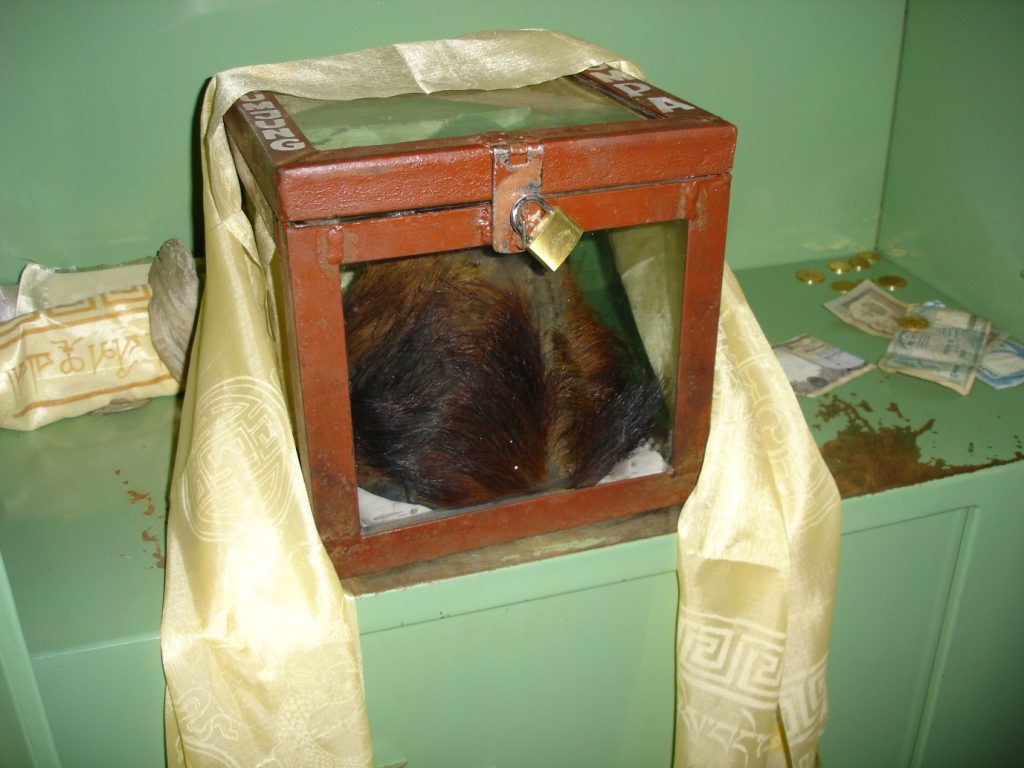
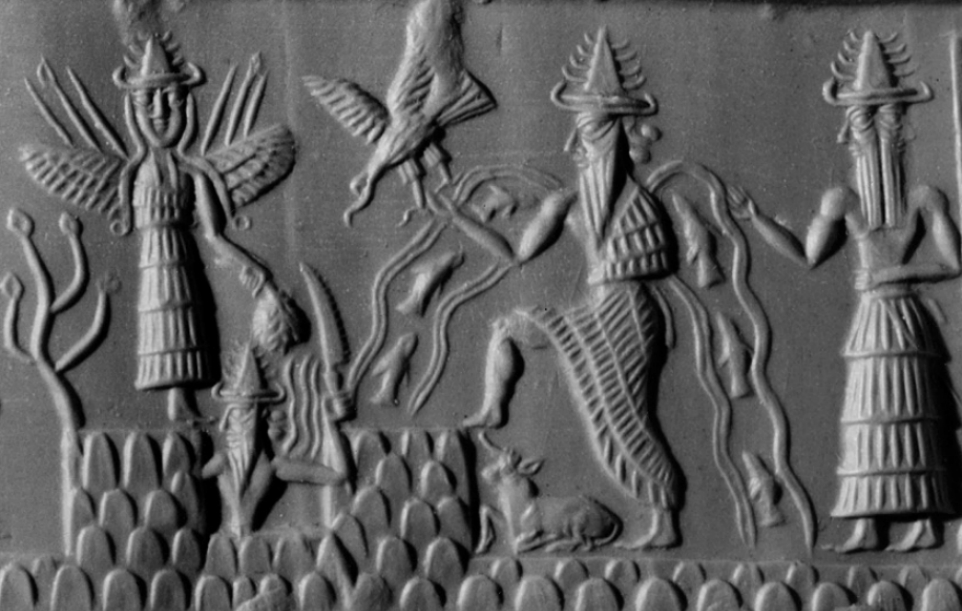
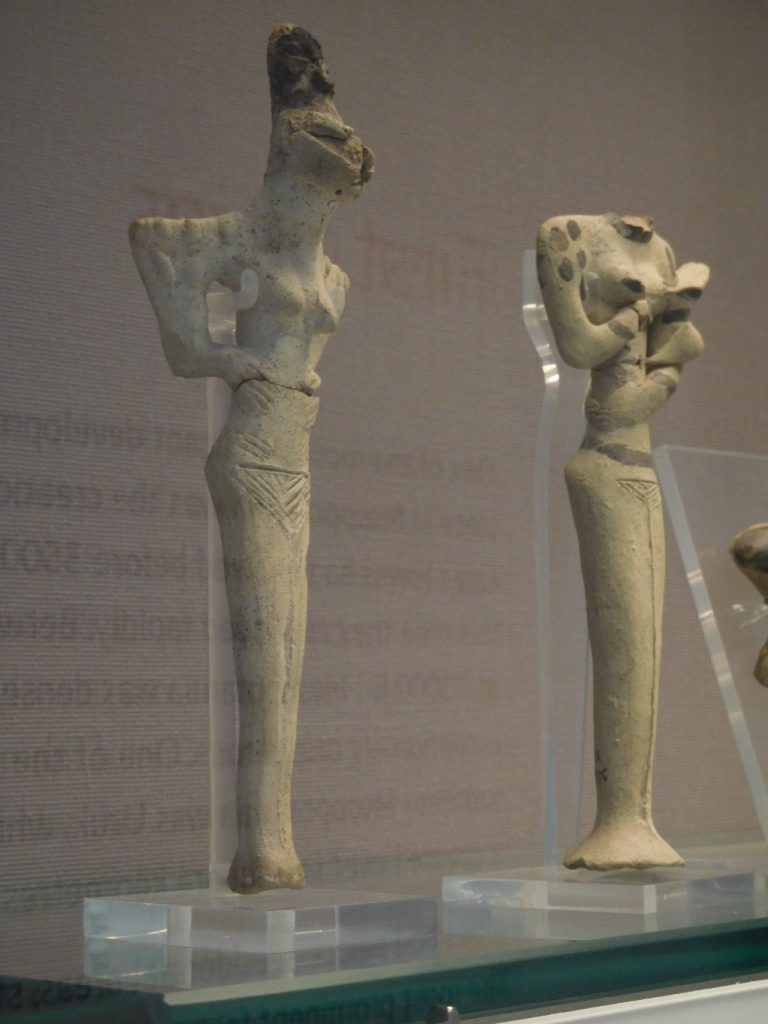
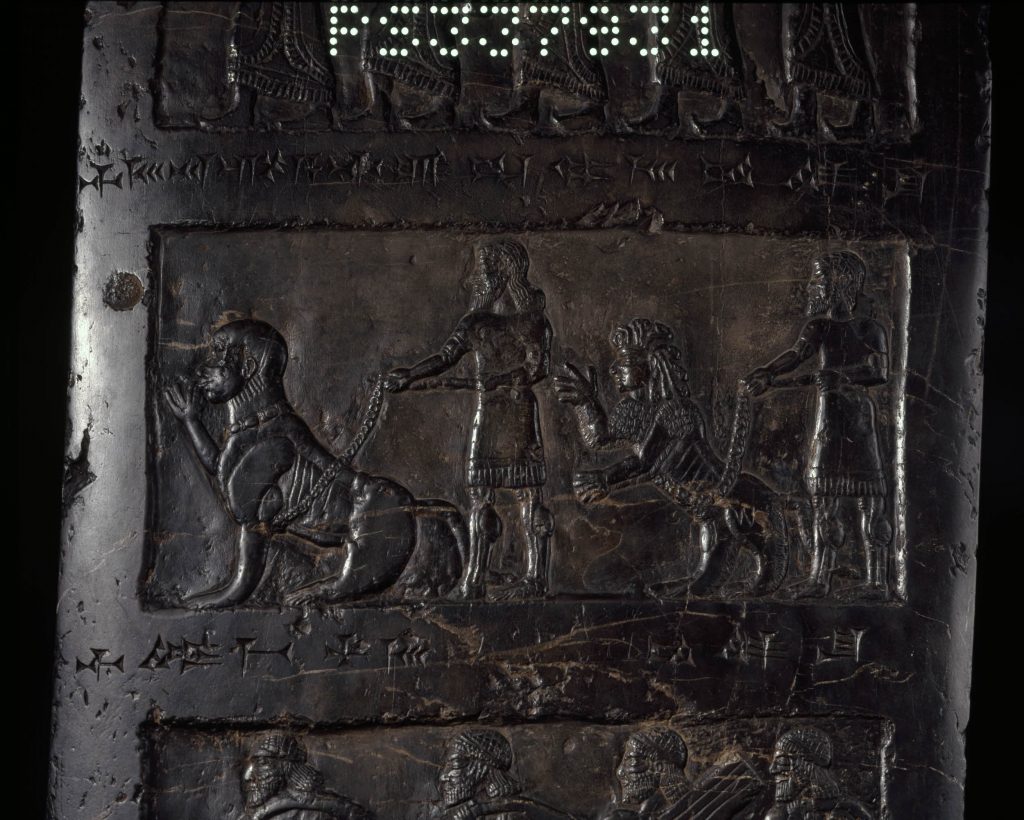

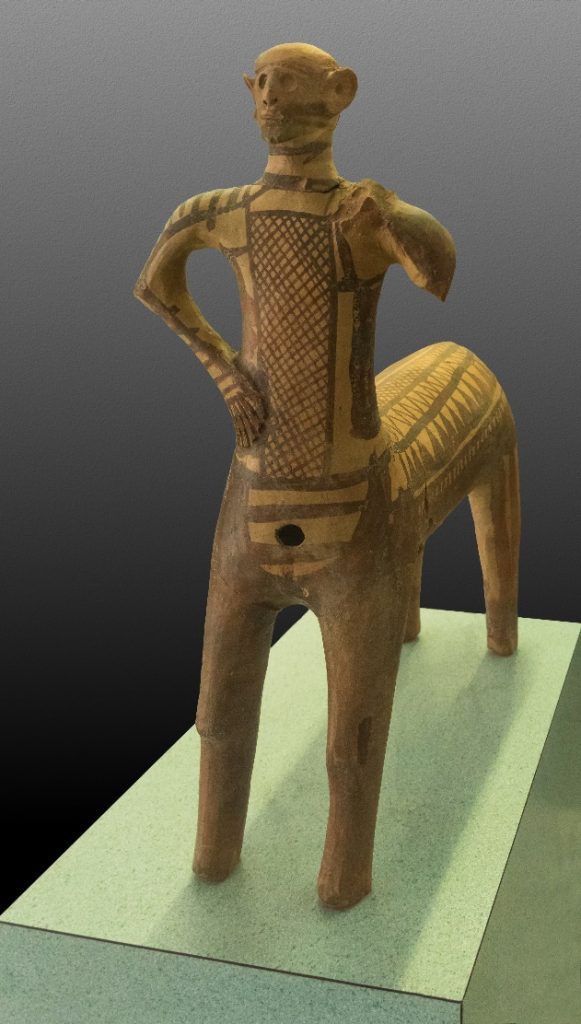
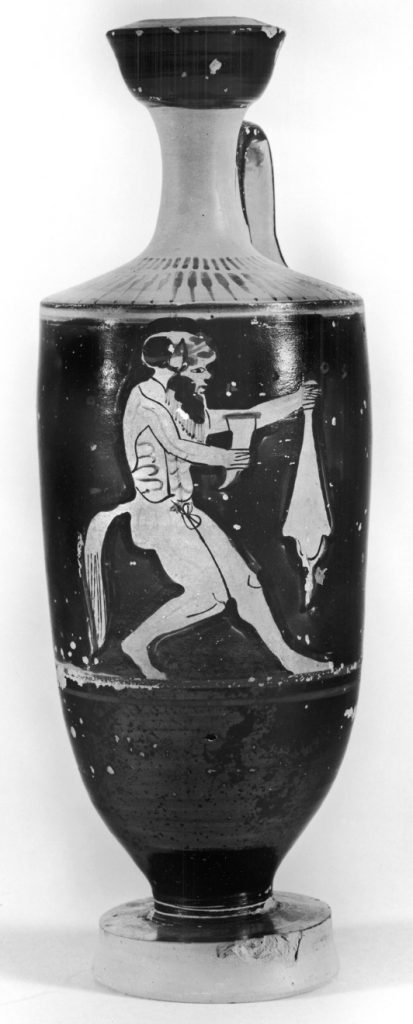
Another fascinating glimpse into the distant past. Brilliant, Von.
GREAT research. Many thanks. However, I wonder why you keep referring to “Sons/Children of God”. Is not the Hebrew
plural ELOHIM used for a sole Deity. Therefore should we not say Sons/Children of “the gods?”
Also, “And Elohim said:
“Let us make Man in our image,
after our likeness.”
Thanks for you comment, Kenneth. You are quite right about what ‘Elohim’ means. However, I use the terms ‘Sons of God/Children of God’ because those are the terms used in the books of the Kolbrin, my core material.
The Kolbrin wording in its modern translation says’Sons of God’/’Children of God’, so that is the wording I use. The nearest the Kolbrin comes to ‘gods’ is its single mention of the mysterious ‘Grand Company’.If, as I think, the Kolbrin was written much earlier than Genesis, then the Hebrew plural would not apply here. Incidentally, the Kolbrin’s Book of Creation contains amazing descriptions of God as viewed metaphysically far back in distant time.
Interesting read. I wonder, is there any academics recognising authenticity of Colbryn yet?
Not to my knowledge. The Kolbrin has no recent provenance and therefore no proven authenticity. Recently I heard that a written version of the Egyptian Books was taken over to North America during the Scottish Land Clearances of the early 19th century and is now in the possession of a religious organisation there, in extremely poor condition. However, I have not been able to authenticate this report. My article ‘Guide to the Kolbrin'(see below in Articles) briefly describes how the books came to be published.
Hi Yvonne . . . this is a very ‘very’ interesting page . . . I’ve been thinking/writing from a very different ‘reality’ is fake while also becoming aware that our ‘history’ just doesn’t add up’ angle which has had me going into a lot of detail in terms of different types of fake ‘reality’ types AND particularly with respect to the possibilities of their being observable evidence of very specific ‘fake’ reality configurations.
You’ll have to bear with me here . . . there are millions of pages written about the ‘matrix/a matrix reality’ BUT strangely they all miss defining/describing the most basic details of exactly how a ‘matrix’ type reality would be different to a real reality, which for ‘rational’ discussions would then by used as the basis to evaluate the differences AND specifically with respect to determining if these differences could/would ‘likely’ result in visible signs of ‘observable’ evidence . . .
For example, if you check up on the meaning of various words in terms of their distant past/original ‘historical’ meanings, then there is evidence supporting that the words for ‘man’ and ‘men’ were originally used to describe ‘not’ individuals but the entire population as being of one single body form i.e. there is evidence ‘suggestive’ that the original meaning and use of the words man and men were actually describing an entire none gendered androgynous population . . .
This would ‘imply’ that the invisible body that is ‘really’ us/you reading this is actually our/your ‘REAL’ original body AND is none gendered and that we’ve been interfaced as an androgynous/none gendered form to a two gendered physical ‘human’ body form, which if you think about it will at least for some people (and perhaps lots) result in the visible presentation of ‘anomalies’ with respect to ‘gender’!!!
Interestingly, you’d have had to have buried your head in a very deep hole to remain unaware that we’ve many, many gender/transgender ‘weirdness’s/anomalies . . . so the question is ‘how would reality have to be’ to explain the ‘gender’ problems why would there be people that ‘really’ feel as if they are the wrong gender or even of NO GENDER AT ALL!!!!
The page you’ve written above Yvonne is about 25 pages of A4 long I’ve some very long ‘fake’ reality evidence pages on: clivehetherington.com (https://www.clivehetherington.com/), if you check out the front page and read down a bit, I’ve a list of 4 pages which are an ‘introduction’ to lot’s more pages all offering evidence of all sorts of very interesting things.
1. Matrix Film, Plato’s Cave, Theory of Forms, Metempsychosis & Platonic Dualism Comparisons
2. Deducible Logistic Problems/Anomalies of Interfacing 7+ Billion Individuals to a 2nd ‘Matrix’ Reality Defined ‘Fake’ Body
3. Two Bodies Interfaced Together ‘Matrix Reality’ Reasoned Speculation & Evidence!!!
4. Matrix Reality Evidence: Androgynous, Asexual Subtle Forms Interfaced to a Two Gendered Physical Body Will Present Anomalies Related to Gender, Validating Transgender Experiences
I’ve not been able to get my head around anomalies related to distant history until recently, Page 1 above (Matrix Film, Plato’s Cave, Theory of Forms, Metempsychosis & Platonic Dualism Comparisons) I’d recommend that Graham himself read, it’s also the page that goes into detail with respect to the distant past word meaning origins which reveals the none gender ‘man/men’ possibilities . . . .
Page 4 (Matrix Reality Evidence: Androgynous, Asexual Subtle Forms Interfaced to a Two Gendered Physical Body Will Present Anomalies Related to Gender, Validating Transgender Experiences) goes into way, way more detail and give many more angles of evidence that we are actually a none gendered species interfaced to a two gendered piss taking ‘human’ body . . .
So, a none gendered race of ‘subtle/energetic’ forms generically labelled/named as men of which individuals could be referred to as a ‘man’ are then deliberately interfaced to a physical form which has two genders a male and a female. Based on what you present on this page Yvonne, this ‘could’ be described/interpreted as a none gendered ‘race’ of men within which each individual is called or referred to as a ‘man’ whom in setting this up would then beget/be responsible for the appearance of both males and females . . . what you write above Yvonne implies that those doing this preferentially interfaced to the human male body form . . . and in then copulating with those that interfaced to a female gendered body would result in them having ‘physical/human’ children (either males of females) . . .
. . . some peoples here see ghosts . . i.e . . dead people, which are very likely to ‘represent’ people temporarily de-interfaced while they wait to be interfaced to the next available human ‘body’, in this respect, it’s possible that early humans ‘saw’ some of the original subtle form subtle ‘beings’ as much larger than themselves i.e. as ‘giants’ . . .
Thank you for these thoughts, Clive. I think you might find some interesting ideas on metempsychosis, dualism, mingling of the earthly and the spiritual etc. in the Kolbrin’s Books of Creation, Gleanings, Scrolls and Manuscripts. One of the things I like about the Egyptian books is that, as in all the most profound writing, extremely complex ideas are communicated so simply and in such a measured way.
The paragraph that I have copied below in my opinion says it all, provided, of course, that the Kolbrin is genuine.
“Putting together what the Kolbrin says about the Sons/Children of God ̶ ‘their forefathers had crossed the great dark void’… that their women ‘followed the ways of the cradleland, not the ways of Earth’ … that they gradually ‘became fully Earth-sustained’xi ̶ something extraordinary emerges: the Kolbrin is saying that the ancestors of the Sons of God came from a place that was not Earth.”
Surely this paragraph confirms that the “Gods” came from afar, across the “dark void”, from another civilisation, in order to either colonise Earth and/or to to genetically modify the genome of the most suitable candidates (primitive hominids) and attempt to raise them to a more advanced and civlised human type.
The term “Grand Company” possibly refers to the wider Galactic community of civilised worlds that maybe oversee planetary intervention projects. As the Earth experiment shows, these interventions are not always controllable and can often produce unwanted results.